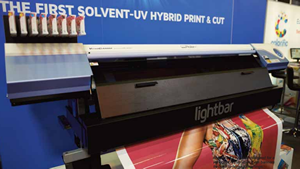The two most common ink technologies in use in wide-format today are solvent, which continues to offer good performance at low cost, and UV-curable, which will work with a wide range of media and can print direct to board. But now we are seeing a new type of ink emerge that combines the best of both of these ink technologies. The new inks are a hybrid technology with both solvent and UV-curable components. Essentially, the solvent is used in very small quantities to soften and key the media surface so that the pigments can penetrate into the media. The UV element then immediately cures the inks so that they are ready for immediate use, with no waiting around for the prints to out-gas. These type of inks typically have a bright colour gamut and a lower film thickness than with UV-curable inks.
Colorific has been amongst the pioneers, developing its UV Light inks, which need a Lightbar fitted to the front of the printer to cure them. The company sells retrofit kits for existing solvent models, as well as complete systems.
One of the early adopters of this technology was Fast Signs (Scotland), based in Airdrie near Glasgow. The company produces a range of general signage, taking on everything from a simple ‘No Smoking’ sign to shop front fascias and vehicle graphics. Rob Lambie, a director of the company, says that the main advantage is that it has sped up production.
“As a sign maker everybody expects everything instantly. With solvent printers you are looking at a minimum of 24 hours before you can mount it or laminate output. Now the prints come straight out of the machine and they are instantly dry and can be mounted within minutes of coming out of the machine.”
Fast Signs installed the Lightbar on a ten-year-old Mark 1 Grenadier from The Light Brigade, a move that Lambie says has given the printer a new lease of life. The installation took two days, which included flushing out the ink and overhauling the printer. Colorific also made profiles for all the media that Fast Signs normally uses.
Lambie says: “The quality of the prints is excellent. There's no difference in the colour gamut. I would say that the quality is better than it was before. All the colours are nice and vibrant.”
He says that Fast Signs tested the prints for abrasion and rub resistance, using everything from ink cleaners to screwdrivers to see how well the prints stood up to abuse, and found that the Lightbar prints had extremely good resistance, better than those from the latex and UV printers that the company also uses.
The Lightbar prints are suitable for outdoor displays but Fast Signs laminates the prints if there’s a requirement for longevity. However, Lambie does add: “We wouldn't use it for vehicle wraps because it doesn't have the same stretch capability. “
Lambie hasn’t had any problems with the Lightbar since installing it a few months ago, adding: “The Lightbar cost
a lot of work and haven't bought that many ink cartridges so it seems like an economical machine to run in terms of ink.” Nor does Eade think that it uses much power, certainly not enough to be noticeable, as the Lightbar is essentially just a high output fluorescent tube.

In conclusion the Lightbar seems to offer a relatively cheap way of rejuvenating an older printer. Moreover, it takes care of one of the major drawbacks of solvent printing - the waiting time for the prints to out-gas - which should considerably speed up production.
{jathumbnail off}

